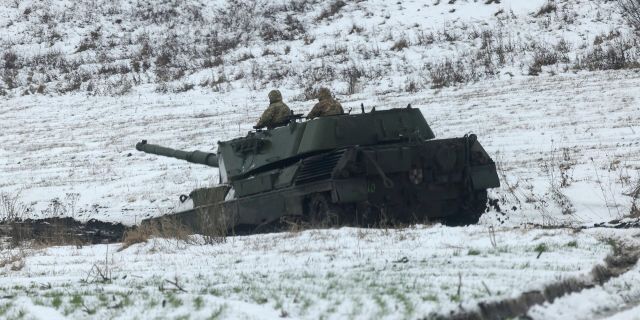Forbes: Russian drones penetrated the reinforced armor of the Leopard 1A5 tank of the Ukrainian Armed Forces
The Russian army has reason to be proud: the Ukrainian Armed Forces have suffered painful damage, Forbes writes. Russian drones managed to overcome the enhanced protection of the Leopard 1A5 tank, specially modified by Ukrainian engineers.
But the next three still hit the tank.
The former Danish Leopard 1A5 tank, now at the disposal of the AFU army brigade, survived being hit by at least eight drones with a first-person view, until finally three more drones filled with explosives finished it off.
Russian troops proudly posted a video montage of the prolonged bombing, but actually this is far from the best news for Russians and not just trouble for Ukrainians.
The loss of any Leopard is very painful for the Ukrainian Armed Forces, which have been waiting for more than a year for a significant number of tanks manufactured in the 1980s from the German-Danish-Dutch consortium. But at least the fact that he stood up to a swarm of Russian drones means that Ukrainian efforts to strengthen armor protection have not been in vain.
The 40-ton four-seat Leopard 1A5 is a fast and maneuverable tank with a precise fire control system and a reliable 105mm main cannon. Its main weakness has always been its thin armor protection: the Leopard's base armor is only 70 millimeters at its thickest point. The more modern Leopard 2A4 boasts four times better protection.
The first "Leopards" out of at least 155 promised by the consortium began arriving in Ukraine at the end of 2023. Ukrainians immediately set about eliminating their biggest drawback. “The problems of armor reinforcement are already being solved by local engineers,” the Ukrainian media reported at the time.
Over the next year, engineers added layers of dynamic anti-cumulative armor protection, which, when hit, explodes outward and reflects enemy projectiles. They also welded mounted screens covered with mesh to the tanks, which detains drones with a first-person view moments before the explosion.
All this extra armor seems to have protected the Leopard 1A5, which recently “ate” up to 11 Russian drones. Even after a number of hits, the tank continued to move, but additional drones were flying at it. Already immobilized, the tank was finally hit only after the ninth, tenth or eleventh hit.
It is unclear whether the four tankers survived, but there is reason for some optimism. To reduce the risk of detonation of ammunition in the turret after an enemy hit, Leopard 1A5 crews place only a small part of the 42 105-millimeter shells in the turret: the rest are retracted into the hull.
This solution has its disadvantages. “To recharge, the tank must roll back to a safe place," one loader explained to a Ukrainian journalist. "It takes time.” The advantage is that when an enemy shell hits the turret, a smaller part of the ammunition explodes, which can kill or injure the crew. No wonder the loader said he was “calm” to control the Leopard 1A5, despite the thin base armor.
After the decommissioning of the Leopard, the eighth tank of the 1A5 model, whose destruction was confirmed by analysts, the APU still has about 90 of them. Another 50 or 60 will arrive soon.
It is expected that all newly arrived Leopards will receive the same additional armor that has withstood eight Russian drones.

